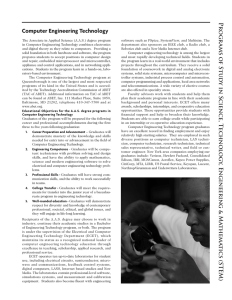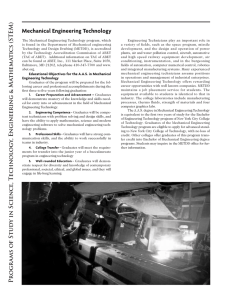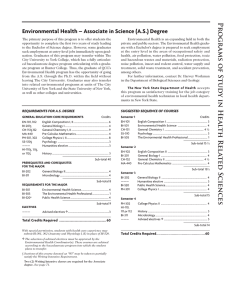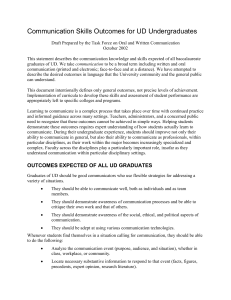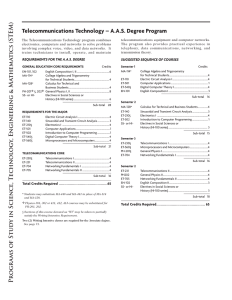Pr ogra ms o )
advertisement
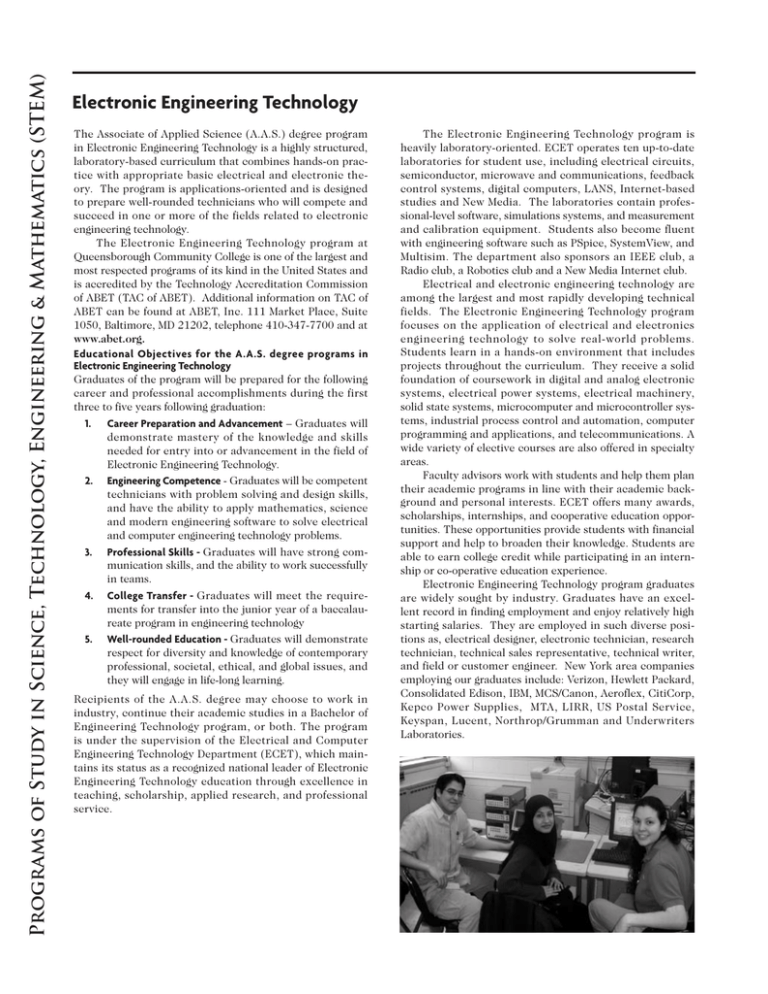
Programs of Study in Science, Technology, Engineering & Mathematics (STEM) The Associate of Applied Science (A.A.S.) degree program in Electronic Engineering Technology is a highly structured, laboratory-based curriculum that combines hands-on practice with appropriate basic electrical and electronic theory. The program is applications-oriented and is designed to prepare well-rounded technicians who will compete and succeed in one or more of the fields related to electronic engineering technology. The Electronic Engineering Technology program at Queensborough Community College is one of the largest and most respected programs of its kind in the United States and is accredited by the Technology Accreditation Commission of ABET (TAC of ABET). Additional information on TAC of ABET can be found at ABET, Inc. 111 Market Place, Suite 1050, Baltimore, MD 21202, telephone 410-347-7700 and at www.abet.org. Educational Objectives for the A.A.S. degree programs in Electronic Engineering Technology Graduates of the program will be prepared for the following career and professional accomplishments during the first three to five years following graduation: 1. Career Preparation and Advancement – Graduates will demonstrate mastery of the knowledge and skills needed for entry into or advancement in the field of Electronic Engineering Technology. 2. Engineering Competence - Graduates will be competent technicians with problem solving and design skills, and have the ability to apply mathematics, science and modern engineering software to solve electrical and computer engineering technology problems. 3. Professional Skills - Graduates will have strong communication skills, and the ability to work successfully in teams. 4. College Transfer - Graduates will meet the requirements for transfer into the junior year of a baccalaureate program in engineering technology 5. Well-rounded Education - Graduates will demonstrate respect for diversity and knowledge of contemporary professional, societal, ethical, and global issues, and they will engage in life-long learning. Recipients of the A.A.S. degree may choose to work in industry, continue their academic studies in a Bachelor of Engineering Technology program, or both. The program is under the supervision of the Electrical and Computer Engineering Technology Department (ECET), which maintains its status as a recognized national leader of Electronic Engineering Technology education through excellence in teaching, scholarship, applied research, and professional service. The Electronic Engineering Technology program is heavily laboratory-oriented. ECET operates ten up-to-date laboratories for student use, including electrical circuits, semiconductor, microwave and communications, feedback control systems, digital computers, LANS, Internet-based studies and New Media. The laboratories contain professional-level software, simulations systems, and measurement and calibration equipment. Students also become fluent with engineering software such as PSpice, SystemView, and Multisim. The department also sponsors an IEEE club, a Radio club, a Robotics club and a New Media Internet club. Electrical and electronic engineering technology are among the largest and most rapidly developing technical fields. The Electronic Engineering Technology program focuses on the application of electrical and electronics engineering technology to solve real-world problems. Students learn in a hands-on environment that includes projects throughout the curriculum. They receive a solid foundation of coursework in digital and analog electronic systems, electrical power systems, electrical machinery, solid state systems, microcomputer and microcontroller systems, industrial process control and automation, computer programming and applications, and telecommunications. A wide variety of elective courses are also offered in specialty areas. Faculty advisors work with students and help them plan their academic programs in line with their academic background and personal interests. ECET offers many awards, scholarships, internships, and cooperative education opportunities. These opportunities provide students with financial support and help to broaden their knowledge. Students are able to earn college credit while participating in an internship or co-operative education experience. Electronic Engineering Technology program graduates are widely sought by industry. Graduates have an excellent record in finding employment and enjoy relatively high starting salaries. They are employed in such diverse positions as, electrical designer, electronic technician, research technician, technical sales representative, technical writer, and field or customer engineer. New York area companies employing our graduates include: Verizon, Hewlett Packard, Consolidated Edison, IBM, MCS/Canon, Aeroflex, CitiCorp, Kepco Power Supplies, MTA, LIRR, US Postal Service, Keyspan, Lucent, Northrop/Grumman and Underwriters Laboratories. Programs of Study in Science, Technology, Engineering(STEM) Electronic Engineering Technology Programs of Study in Science, Technology, Engineering(STEM) A TAC of ABET ACCREDITED ENGINEERING TECHNOLOGY CURRICULUM REQUIREMENTS FOR THE A.A.S. DEGREE GENERAL EDUCATION CORE REQUIREMENTS SUGGESTED SEQUENCE OF COURSES Credits EN-101, 102 English Composition I, II..........................................................6 MA-114* College Algebra and Trigonometry for Technical Students.............................................................4 MA-128* Calculus for Technical and Business Students................4 PH-201✥, 202✥ General Physics I, II.....................................................................8 SS- or HI- Electives in Social Science or History (HI-100 series)............................................................. 6 Sub-total 28 REQUIREMENTS FOR THE MAJOR ET-110 ET-140 ET-210§, 220 ET-230§ ET-320§ ET-410 ET-501 ET-509 ET-510§ ET-560§ Electric Circuit Analysis I.........................................................4 Sinusoidal and Transient Circuit Analysis.........................3 Electronics I, II.............................................................................8 Telecommunications I..............................................................4 Electrical Controls Systems...................................................3 Electronic Project Laboratory............................................... 1 Computer Applications........................................................... 1 C++ Programming for Embedded Systems....................... 1 Introduction to Digital Computers.....................................4 Microprocessors and Microcomputers.............................4 Sub-total 33 ELECTIVES ———— ET electives✥✥...........................................................................3 Semester 1 MA-114*College Algebra and Trigonometry for Technical Students..........................................................4 ET-110 Electric Circuit Analysis I.....................................................4 ET-501 Computer Applications.........................................................1 ET-510§ Introduction to Digital Computers.................................4 EN-101 English Composition I........................................................... 3 Sub-total 16 Semester 2 MA-128* ET-140 ET-210§ ET-509 SS- or HI- * Students may substitute MA-440 and 441 in place of MA-114, 128. ✥ Physics 301, 302 or 411, 412, 413 courses may be substituted for PH-201, 202. ✥✥ Elective credits for the Electronic Engineering Technology program may be chosen from ET-305, 360, 481, 490, 502, 503, 504, 505, 506, 507; 701, 704, 705, 706, 707, 710, 712, 720, 840, 991, 992, 993 (see Course Descriptions). § Sections of this course denoted as “WI” may be taken to partially satisfy the Writing Intensive Requirement. Two (2) Writing Intensive classes are required for the Associate degree. See page 71. Calculus for Technical and Business Students..........................................................4 Sinusoidal and Transient Circuit Analysis..................... 3 Electronics I...............................................................................4 C++ Programming for Embedded Systems..................1 Electives in Social Science or History (HI-100 series).......................................................... 3 Sub-total 15 Semester 3 ET-220 EN-102 ET-560§ ———— PH-201 Total Credits Required............................................. 64 Note: On the basis of a Speech Placement Test administered to all students upon admission, up to two semesters of remedial speech may be required. Credits Electronics II.............................................................................4 English Composition I........................................................... 3 Microprocessors and Microcomputers......................4 ET elective✥✥...........................................................................1 General Physics I.....................................................................4 Sub-total 16 Semester 4 ET-230§ ET-410 ET-320§ PH-202 SS- or HI- Tech Elective Telecommunications I...........................................................4 Electronic Project Laboratory.............................................1 Electrical Controls Systems................................................ 3 General Physics II....................................................................4 Electives in Social Science or History (HI-100 series).......................................................... 3 ET elective✥✥..........................................................................2 Sub-total 17 Total Credits Required............................................. 64 Programs of Study in Science, Technology, Engineering & Mathematics (STEM) Electronic Engineering Technology – A.A.S. Degree Program
